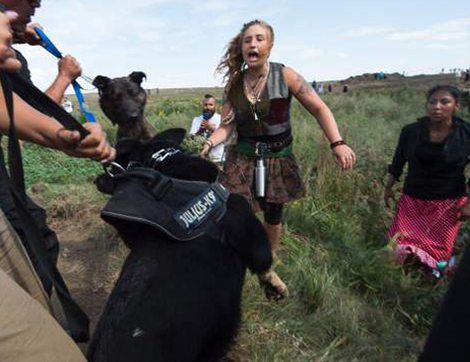
Demonstrators from across the country have joined with American Indians in North Dakota to protest a private oil firm that plans to run an oil pipeline underneath the Missouri river, the only source of clean drinking water for thousands of people in the area. The pipeline is planned to transport about 470,000 barrels of crude oil per day.
By Ronald Ray
The Standing Rock Sioux Tribe of the Dakota and Lakota Nations of American Indians has been seeking peacefully to block further construction of the 1,172-mile-long Dakota Access oil pipeline, which threatens the tribe’s water supply and sacred spaces. The tribe, recognized by the U.S. as a sovereign nation by treaty, thus has earned the wrath of Big Oil plutocrats and, consequently, law enforcement authorities.
In a separate article in this issue we recount the jury acquittal of seven defenders of private property rights, who earlier this year occupied the Malheur National Wildlife Refuge in Oregon, including sons of rancher Cliven Bundy. But unlike that peaceful protest, as well as the famous defense of the Bundy ranch in Nevada two years ago, the Indians have chosen to remain unarmed, despite sometimes facing vicious brutality by police and private security firms, which has included siccing biting attack dogs on protestors, arrests of reporters, and strip searches of arrestees.
The effort to protect the Missouri River—the Standing Rock Sioux’s primary water source—and sacred burial grounds now includes the participation of more than 300 native tribes and thousands of “water protectors” occupying federal land near the pipeline’s route south of Bismarck, N.D.
While filming an interview with a Native American man, Erin Schrode allegedly became a victim of excessive force by police Wednesday. She was interviewing activists protesting the Dakotas Access Pipeline, which they say threatens water used by the Standing Rock Sioux Tribe, when she says she was shot by a rubber bullet.
Facing militarized sheriff’s deputies from seven states, contracted security and National Guardsmen, the success of the unarmed Standing Rock Sioux and supporters remains dependent on an uncertain lawsuit result in federal court. That outcome will decide the safety of water supplies for millions of people who live along the pipeline route and in the Missouri and Mississippi river basins below the pipeline.
Emigrate While You Still Can! Learn More . . .
The pipeline’s original route was to pass through Bismarck, a town of approximately 61,000 people, but in 2014, the U.S. Army Corps of Engineers determined the pipeline might contaminate local drinking water. Consequently, the route was moved to pass near the Standing Rock Indian Reservation and its inhabitants, where the Army suddenly found no such danger, despite the pipeline’s having to pass under Lake Oahe and the Missouri River.
Charges of racism, perhaps founded, have arisen. While Energy Transfer Partners (ETP), which is building the pipeline, claims the pipeline is safe, the corporation has a dubious record. At least four current lawsuits have been brought against ETP by states and localities for groundwater contamination, while seven other states have cited the oil company for release of hazardous materials, according to the National Lawyers Guild (NLG).
Similar to the widespread pollution caused by fracking, the NLG stated more than 300 pipeline breaks occurred in North Dakota in one year alone. In January 2015, 50,000 gallons of Bakken crude oil—the same as will pass through the Dakota Access pipeline—spilled into the Yellowstone River in Montana.
In answer to the tribe’s repeated complaints, the Department of the Interior and two other federal agencies have ordered a halt to pipeline construction on federal land around Lake Oahe, due to significant environmental concerns. The Army must now carry out a more thorough study than the previous “fast track” report. ETP remains determined to open the pipeline by early 2017, however.
The Indians’ protest occupation of federal lands began with a single teepee last April and burgeoned over the summer to as many as 3,000 people. Despite frequent confrontations with ETP security contractors and law enforcement authorities, the protestors have remained almost entirely peaceful, even when subjected to police brutality.
The occupiers’ intent to remain through the bitter North Dakota winter and moves to establish appropriate infrastructure have frustrated developers and the county sheriff, leading to increased tensions.
The Standing Rock Sioux Tribe’s decision in late October to apply eminent domain to private property on the pipeline route and to occupy the former burial ground led to a confrontation with militarized law enforcement on Oct. 27.
The tribe based its actions on the 1851 Fort Laramie Treaty, which included those lands as Indian territory that the Sioux nations never ceded.
On Oct. 26, the Federal Aviation Administration established a “no-fly zone” over the protest encampment near Cannon Ball, N.D., effective until Nov. 5. The next day, as two vehicles were set on fire by alleged protestors, 200-300 law enforcement personnel and National Guardsmen moved against protestors’ barricades and prayer groups on the occupied private property. Armored vehicles, large amounts of pepper spray, police batons, painful sound cannons, rubber and bean-bag bullets, smoke grenades and tasers were used to corral protestors, according to The Bismarck Tribune. Jamming of video and mobile telephone signals was also reported. Police arrested 141, while the others retreated to federal land.
In this case, the government is disregarding the private property rights of the Standing Rock Sioux—their rights to safe, clean drinking water and land free of pollutants—in favor of monied corporate interests. But the issue also affects the millions of Americans and wildlife downriver.
Business interests must be limited by the welfare of the people. No one has the right to endanger the land and water necessary to sustain life for generations of human beings. And think about how you would feel if Big Oil bulldozed your great-great grandmother’s grave.
Ronald L. Ray is a freelance author and an assistant editor of THE BARNES REVIEW. He is a descendant of several patriots of the American War for Independence. Contact Ron by email at [email protected].


..and not to mention the Animal abuse being demonstrated via the rogue cops! (dogs forced to attack/intimidate innocent human beings)! You may want to watch: [Jay Arae Essex – the Hopi “Pahana” etc.]: How Your Governments Will Be Destroyed and… Your Awakening 8/18/16: https://youtu.be/PNKnhtcKYrY
Ronald did an awesome job on this article clearly explaining we
once again are having our sovereign rights attacked by the so called government which is merely a “government services” Corporation who acts in a profiteering manner rather than a Public Rights concern.
Law enforcement has no rights to be on Private Property it is a trespass and especially where Indian tribes are concerned.
ETP sounds like a “can of worms” and I stand WITH the protestors rights and would like to know more about the lawsuit that is pending as that seems to be the ONLY way to stop this craziness.
How many are aware that their safety of water supplies is in danger. It states millions of people who live along the pipeline route and in the Missouri and Mississippi river basins below the pipeline can be affected and I believe they will. Why haven’t they joined in to stop the nonsense?
This is not just an Indian issue…this is an American issue and we have a right to Peacefully assemble without the brutality going on.
I would have loved to read more about the lawsuit and the schedule of that because an impact can be made there and should be a focal point. Protests need to be daily so this issue cannot be swept under a rug. ETP does not sound qualified to be doing this project and I believe stopping them is crucial.